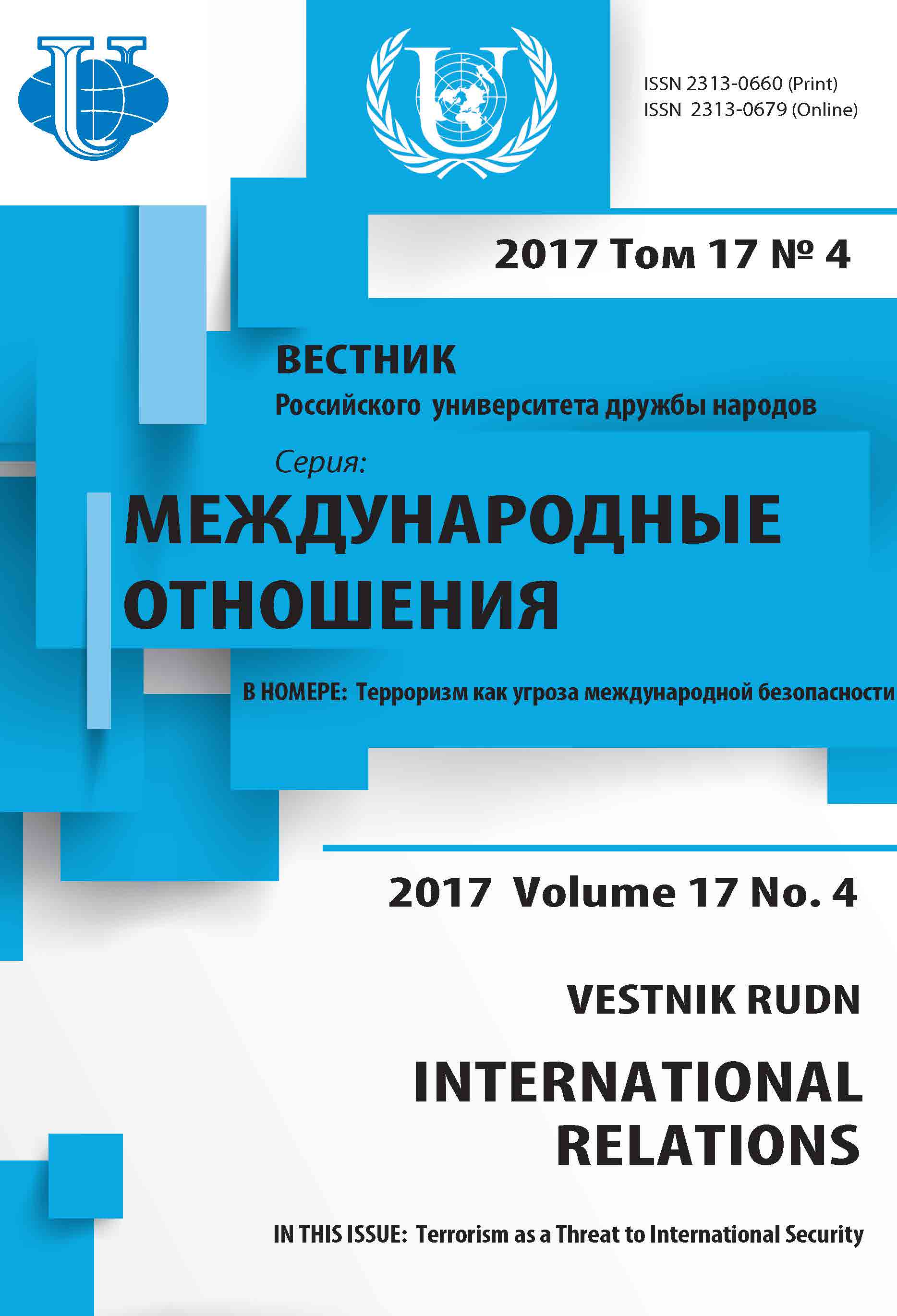РОССИЙСКАЯ И КИТАЙСКАЯ СИСТЕМЫ ОКАЗАНИЯ МЕЖДУНАРОДНОЙ ПОМОЩИ: СРАВНИТЕЛЬНЫЙ АНАЛИЗ
- Авторы: Дегтерев ДА1, Янь Л.2, Трусова АА1
-
Учреждения:
- Российский университет дружбы народов
- Институт мировой экономики и политики, Китайская академия общественных наук
- Выпуск: Том 17, № 4 (2017): Терроризм как угроза международной безопасности
- Страницы: 824-838
- Раздел: МЕЖДУНАРОДНЫЕ ЭКОНОМИЧЕСКИЕ ОТНОШЕНИЯ
- URL: https://journals.rudn.ru/international-relations/article/view/17539
- DOI: https://doi.org/10.22363/2313-0660-2017-17-4-824-838
Цитировать
Полный текст
Аннотация
Предметом данного исследования являются механизмы оказания международной помощи в РФ и КНР. Авторы проводят сравнительный анализ нормативных баз двух государств в сфере содействия международному развитию, организационных структур, понятийного аппарата, специфики и сфер оказания внешней помощи. Методологическая основа данного исследования строится на принципах достоверности и научной объективности. В исследовании применен метод сравнительно-сопоставительного анализа. Стратегическое партнерство РФ и КНР, в том числе сопряжение проекта Экономического пояса Шелкового пути и Евразийского экономического союза, создает предпосылки для успешного взаимодействия двух государств в области оказания международной помощи третьим странам. В законодательстве КНР существует концептуальная основа оказания официальной помощи развитию, в нее входят Белые книги и другие политические документы, закрепляющие принципы, цели и задачи, механизм реализации внешней помощи Китая. В РФ существует Концепция государственной политики в сфере содействия международному развитию (СМР), которая отражает цели, задачи, принципы осуществления СМР, но не утверждает на законодательном уровне механизм оказания помощи. В обеих странах также отсутствует специализированный государственный орган, который бы осуществлял политику в сфере СМР. Речь идет скорее о целом ряде государственных органов в сфере оказания международной помощи, деятельность которых в той или иной степени координируется на межведомственной основе. Анализ доктринальных и нормативных документов, а также существующих программ международной помощи РФ и КНР, страновых и отраслевых приоритетов позволяет выработать рекомендации по координации усилий РФ и КНР в области СМР, что приведет, в конечном счете, к повышению эффективности национальных программ международной помощи.
Об авторах
Д А Дегтерев
Российский университет дружбы народов
Автор, ответственный за переписку.
Email: Degterev_DA@rudn.university
Дегтерев Денис Андреевич - канд. эконом. наук, доцент, заведующий кафедрой теории и истории международных отношений Российского университета дружбы народов
Ли Янь
Институт мировой экономики и политики, Китайская академия общественных наук
Email: liyan9339@163.com
Ли Янь - д-р ист. наук, профессор, научный сотрудник Института мировой экономики и политики, Китайская академия общественных наук, Пекин, КНР
А А Трусова
Российский университет дружбы народов
Email: 1032152385@rudn.university
Трусова Александра Андреевна - студент кафедры теории и истории международных отношений Российского университета дружбы народов
Список литературы
- Дегтерев Д.А. Российская политика в сфере содействия международному развитию: контуры партнерства со странами БРИКС // Вестник Российского университета дружбы народов. Серия: Международные отношения. 2014. № 1. С. 5-12.
- Дегтерев Д.А. Содействие международному развитию: Эволюция международно-правовых режимов и эффективность внешней помощи. М.: ЛЕНАНД, 2013. 320 с.
- Ермолов М.О. Российский механизм международной помощи: незавершенный проект // Вестник международных организаций. 2015. № 3. С. 134-155.
- Иностранная помощь / Под общ. ред. Л.М. Капицы. М.: МГИМО (У) МИД, 2013. 652 с.
- Мардашев А.А. Китайская модель помощи международному развитию // Вестник МГИМО. 2011. № 6. С. 96-106.
- Михневич С.В. Содействие развитию торговли и подходы КНР к предоставлению международной помощи // Россия и Китай: проблемы стратегического взаимодействия: сборник Восточного центра. 2014. № 15. С. 46-55.
- Национальные стратегии содействия международному развитию. М.: НИУ ВШЭ, 2010.
- Потапенко М.В. КНР как новый международный донор: особенности политики содействия международному развитию // Вестник Российского университета дружбы народов. Серия: Международные отношения. 2014. № 1. C. 19-31.
- Рахмангулов М.Р. Становление системы содействия международному развитию в России // Вестник международных организаций. 2010. № 2. С. 196-215.
- Федоровский А.Н., Вода К.Р. Помощь развитию во внешней стратегии Китая, Республики Корея и Японии // Мировая экономика и международные отношения. 2016. Т. 60. № 12. С. 82-91.
- Balakova E., Spanger H.-J. Development Cooperation or Competition? Russia as a re-emerging donor. PRIF-Report No. 123. Peace Research Institute Frankfurt (PRIF), 2013.
- Berthélemy J.C. China’s Engagement and Aid Effectiveness in Africa. African Development Bank Working Paper #129. Tunis, Tunisia: African Development Bank, 2011.
- Dreher A., Fuchs A., Parks B., Strange A., Tierney M. Apples and Dragon Fruits: The Determinants of Aid and Other Forms of State Financing from China to Africa. AidData, October 2015. Working Paper 15.
- Gu Guan - Fu. Soviet aid to the third world, an analysis of its strategy // Soviet Studies. 1983. 35:1. P. 71-89.
- Larionova M., Rakhmangulov M., Berenson M. The Russian Federation’s International Development Assistance Programme: A State of the Debate Report. IDS, Evidence Report No 88. Rising Powers in International Development. IDS, August 2014.











